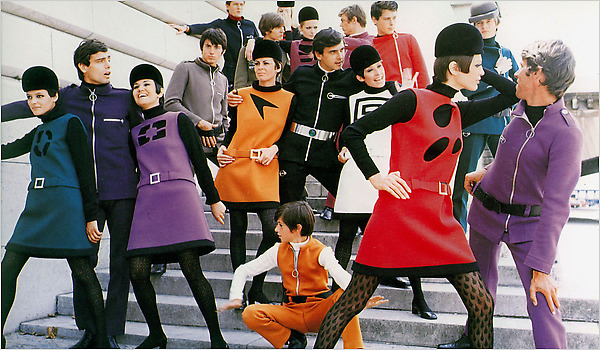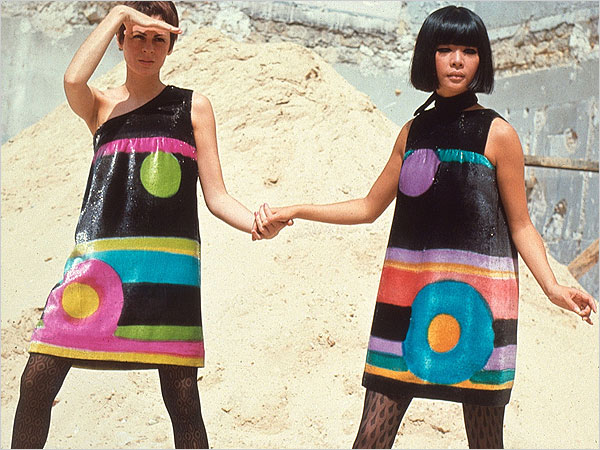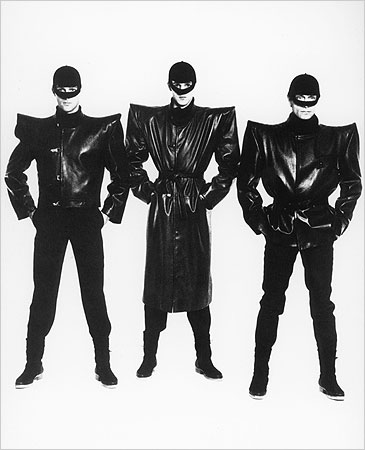By SUZY MENKES
Published: March 22, 2010
PARIS — It is 60 years since Pierre Cardin, fashion’s eternal futurist, opened his Paris fashion house; half a century since he first brought his designs to a desolate, postwar Japan; and more than two decades since he pioneered fashion in China, becoming such a cultural super star that he was watched by this journalist in Beijing in 1993 being cheered and smothered with bouquets of flowers.
But face to face, Mr. Cardin is short on reminiscences about Mao jackets and bicycles and minimizes the historic forward march of his long career. There is only one subject that really interests this 87-year-old designer: What is he doing for tomorrow’s world?
“When I started 60 years ago, the fashion I was drawing was something strange — people said I was crazy and they never wanted to wear my clothes,” said Mr. Cardin, signing copies of his commemorative book at Maxim’s, the historic Parisian Belle Époque restaurant, that he owns and has turned into a global brand.
“My way was to draw something of the future — to be young, to see that a woman could be free,” said Mr. Cardin. “I wanted to give women in the 1960s a chance to work, to sit, to take the car and drive in my dresses.”
The new architecture that the designer built to express the physical and mental emancipation of women is vividly illustrated in “Pierre Cardin, 60 Years of Innovation,” written by Jean-Pascal Hesse, his long-term collaborator, and published by Assouline.
The 1960s dresses, square-cut to free the body, but with all sorts of circular cutouts and satellite sleeves spinning in orbit round the arms, are icons of the space age. The alien innocents in their aviator helmets, miniskirts and colorful hose, expressed the explosion of a new youth culture.
The landmark Cosmos collection of 1964, with tunic and hose for both men and women, was a confident statement about unisex clothing. It anticipated the masculine/feminine fashion standoff that dominated the second half of the 20th century.
There are iconic pieces: the 1968 minidresses in “Cardine,” an early experiment with techno fabric; a circular 1969 vinyl raincoat; or even a felt 1971 envelope hat. Perhaps the most striking thing about the designs is not their sharp angles and compass twirls. It is that they could all walk right out on the street today and not seem out of place.
In fact, today’s students seem to be catching up with Mr. Cardin’s style. During London Fashion Week last month, there was a dominance of 3-D dresses with angular cuts, created, as if they were the designer’s disciples, by the class of 2010 at Central Saint Martins college of art and design.
“I have a very big respect for English design, because they are provocation, and when you provoke, something stays after,” says Mr. Cardin.
Yet his own fashion training was a conventional apprenticeship in haute couture, where he learned his precise cutting skills. After a tough childhood, as his parents, escaping Italy’s Fascist regime, settled in France in 1924, “Pietro Cardin” was apprenticed to a tailor and then worked at the houses of Paquin, Schiaparelli and Christian Dior. He remembers the artistic milieu when he worked with the decorative artist Christian Bérard to design costumes for Jean Cocteau’s legendary 1946 movie “La Belle et la Bête” (Beauty and the Beast).
But the radical designer was never comfortable inside a shell of couture gentility. He scandalized the fashion world when he introduced ready-to-wear clothes in 1959 — for which egalitarian gesture he was flung out of the Chambre Syndicale, couture’s ruling body.
From then on, Mr. Cardin was considered a maverick and an outsider, criticized for creating furniture that looked as though it were extruded from a space ship (although he explains that he would “buy the tree, cut the wood and make the drawing.”) The designer was berated for building an empire on licenses for anything from men’s shirts to a frying pan — even though it made him a fortune, which he invested in classic French real estate, including the Marquis de Sade’s castle in the Lubéron district. There he holds annually one of his many cultural events.
“I am presenting ‘Casanova,’ a comedy musicale in the Place San Marco in Venice next July,” says Mr. Cardin. “And last year I made ‘Marco Polo’ in China. I try to make my life enjoyable.” He was referring to a ballet about the exotic travels of the medieval explorer Marco Polo, interpreted by the Shanghai ballet to usher in the Chinese Lunar New Year.
The boldly illustrated book, with its images of the colorful circle furniture and of the visionary zippered-jersey masculine sportswear, is a monument to the Pierre Cardin oeuvre. But the designer’s legacy is also about his visits to China and his early vision of fashion’s dormant dragon, which he helped to awaken. Subsequently he has pioneered other areas, showing collections in front of 200,000 onlookers in Moscow’s Red Square in 1991 and opening up Vietnam in 1993. His aim is always, even in his late ’80s, to appeal to the next generation.
Perhaps the most interesting angle on the Pierre Cardin legacy is its current relevance, as viewed by a designer who was not even born when the geometric futurism was created.
Louise Goldin, 30, a graduate from Central Saint Martins, found a Cardin image of an outfit, paneled in leather, during research for her autumn 2010 collection.
“It is beautiful and it still looks so futuristic — and that is the way I have been working,” says Ms. Goldin. “I like to challenge myself. There were a lot of elements of 3-D. But that is the moment we are in. His images still look so incredibly modern.”



(interesting image here as almost everyone seems to assume thierry mugler is responsible for the creation of the extreme wide-shoulder...)
the influence expressed by louise goldin's latest

*nytimes.com
video-
http://video.nytimes.com/video/2010/03/22/style/1247467421102/sixty-years-of-pierre-cardin.html


